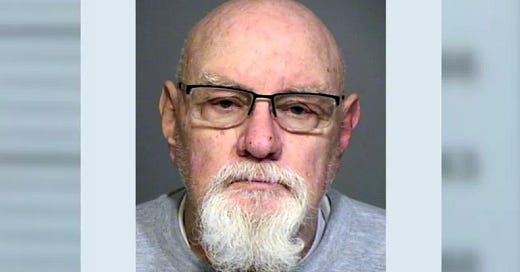Accused Serial Murderer Warren Luther Alexander and the Serial Killer Trucker Club
Predators Trolling America's Highways
Before August 1, 2024, there were twenty-five serial killer truckers behind bars, convicted of multiple murders. As of today, there are twenty-six.
73-year-old Warren Luther Alexander
As the dog days of summer drag on, 73-year-old Warren Luther Alexander finds himself in the hot seat. Since August 7. 2024, he has been sitting in a Ventura County, California jail, charged with three first-degree murders committed nearly half a century earlier. In 1977, the bodies of Kimberly Fritz, 18, Velvet Sanchez, 31, and Lorraine Rodriguez, 21, were discovered in Ventura County, northwest of Los Angeles. The victims shared several commonalities that immediately caught the attention of local law enforcement:
All three women were sex workers known to frequent the Plaza Marina Shopping Center in South Oxnard and nearby motels.
Each victim had been strangled to death, reportedly with their own underwear.
The bodies were arranged in identical positions, which the coroner noted was likely intended to degrade the victims.
Ventura County District Attorney Erik Nasarenko had long suspected these three crimes were connected due to the "patterns and similarities" in the deaths. The coroner at the time said it was unlikely more than one killer would commit crimes with such similar details. Despite these connections, the case went cold.
from left to right: Kimberly Carol Fritz (18), Velvet Ann Sanchez (31), and Lorraine Rodriguez (21)
Generations of detectives worked tirelessly for forty-seven years, refusing to let these women be forgotten. But it would take advancements in DNA technology and a seemingly unrelated arrest to finally break the case open.
The North Carolina Connection: Nona Stamey Cobb
Fast forward from 1977 to July 6, 1992. Nona Stamey Cobb, a 29-year-old woman, was last seen at the Welcome Center on Interstate 85 in Cleveland County, North Carolina. Witnesses reported seeing her get into a truck driven by an unidentified male. The following day, Cobb's body was discovered on the northbound side of Interstate 77 in Surry County, over 100 miles away.
29-year-old Nona Cobb
Like the California victims, Cobb had been strangled. The similarities in the four crimes - a sex worker victim, the method of killing, and the body left near a highway would later provide behavioral evidence connecting Alexander to multiple murders. However, no one saw it, given the distance and time frame (VICAP was nonexistent).
For three decades, Cobb's murder remained unsolved. But in March 2022, investigators re-examining evidence from the case linked DNA from the crime scene to Warren Luther Alexander. On March 15, 2022, Alexander was arrested at his home in Diamondhead, Mississippi, and charged with Cobb's murder. The dominos were about to fall.
In February 2023, the Ventura County Sheriff's Office Cold Case Unit reopened the investigations into the deaths of Fritz, Sanchez, and Rodriguez. Using advanced DNA technology, they re-entered the evidence into CODIS, leading to the match with Alexander's profile. Alexander's DNA from Cobb's murder proved to be the key that unlocked the California cold cases. When law enforcement uploaded his DNA profile to the Combined DNA Index System (CODIS), it matched evidence preserved from the 1977 crime scenes in Ventura County.
The Life of Warren Luther Alexander
So, who is this man currently charged with four sexually motivated murders?
Born on January 12, 1051, Warren Luther Alexander's early life seemed unremarkable. He grew up in Oxnard, California, attending local schools in the 1950s and 1960s. Like many young men of his generation, Alexander joined the military, serving in the U.S. Marine Corps. This period of his life coincided with the Vietnam War era, a time that left many veterans struggling with post-traumatic stress and readjustment to civilian life.
After his military service, Alexander worked as a taxi driver for a time, a job that, in hindsight, may have given him a taste for the transient lifestyle and interactions with strangers that would later characterize his time as a long-haul trucker. It was in the 1970s that Alexander returned to Oxnard and began his career in trucking. This profession would define the next three decades of his life - and potentially provide the means and opportunity for a series of brutal murders.
Alexander's time in Oxnard during his youth and his return in the 1970s coincides with the timeframe of the California murders. This local knowledge may have given him an advantage in selecting victims and avoiding detection.
The gap between the 1977 California murders and the 1992 North Carolina killing raises questions about Alexander's activities during this period. Investigators are now reviewing unsolved cases along his known trucking routes, suspecting that additional victims may have yet to be connected to him. Sadly, he is just one of several serial killers who have masqueraded as long-haul truckers.
The Highway Serial Killings Initiative: Origins and Evolution
The arrest of Warren Luther Alexander is part of a larger pattern that the Federal Bureau of Investigation (FBI) has been tracking since the early 2000s. As investigators delve deeper into Alexander's background, they're piecing together a life that, in many ways, fits the profile of other identified serial killer truckers. In 2004, the Oklahoma State Bureau of Investigation reached out to the FBI's Violent Criminal Apprehension Program (ViCAP) after noticing a disturbing number of murdered women found along highways. This finding prompted ViCAP analysts to look for similar patterns nationwide.
What they found was hundreds of homicides spanning decades, often sharing common elements:
Victims were primarily women engaged in high-risk activities such as sex work, hitchhiking, or substance abuse.
Bodies were discovered along or near highways, often at truck stops or rest areas.
Many cases crossed jurisdictional lines, making them difficult to investigate and connect.
The Highway Serial Killings (HSK) Initiative, officially launched in 2009, grew out of this alarming discovery. The FBI, recognizing the need for a coordinated response, established the Highway Serial Killings Initiative. The program aims to:
Collect and analyze data on highway-related murders
Identify potential serial killers operating across state lines
Coordinate investigations between local, state, and federal law enforcement agencies
Provide support and resources to help solve these complex cases
Since its inception, the initiative has identified over 850 victims and approximately 450 potential suspects.
The Trucker-Serial Killer Connection: Understanding the Link
It goes without saying (although I still feel the need to say it) that most truckers are law-abiding citizens who spend their work hours transporting goods that are essential to our economy: food, clothing, electronics, and construction materials. Without them, some of our industries would come to a grinding halt. And indeed, there's nothing about the profession itself that turns people into killers.
But for someone who already harbors homicidal urges, trucking can provide the perfect environment to act them out and get away with it:
Mobility and Anonymity: Truckers travel extensively across state lines, making connecting crimes committed in different jurisdictions difficult. This mobility also allows them to avoid detection and establish alibis.
Lack of Supervision: Long-haul truckers operate with minimal direct oversight, allowing those with criminal inclinations to act without immediate scrutiny.
Access to Vulnerable Victims: Truck stops and highways are often frequented by individuals engaged in high-risk behaviors, such as sex work, illegal drug use, or hitchhiking. These potential victims may be less likely to be immediately reported missing or have robust support systems.
Isolation and Psychological Factors: Long periods of solitude on the road can exacerbate existing antisocial tendencies or mental health issues. The stress of the job, irregular sleep patterns, and limited social interaction may contribute to psychological instability in predisposed individuals.
Opportunity and Control: The cab of a truck provides a mobile, private space where a predator can exert complete control over a victim. It also serves as a means of quick escape from crime scenes.
Familiarity with Law Enforcement Patterns: Regular long-haul routes may give offenders intimate knowledge of police patrol patterns, enabling them to avoid detection.
Investigating Long-Haul Serial Killers: Unique Challenges and New Opportunities
The case of Warren Luther Alexander highlights the distinct challenges law enforcement faces when investigating potential serial killers among long-haul truckers:
Jurisdictional Issues: Crimes committed across state lines involve multiple law enforcement agencies, complicating investigations and prosecutions. The HSK Initiative aims to bridge these gaps, but coordination still needs to be improved.
Delayed Discovery of Bodies: Victims left along highways may not be discovered for days or weeks, leading to degradation of physical evidence and complicating time of death determinations.
Limited Forensic Evidence: Outdoor crime scenes, exposure to elements, and decomposition often result in minimal physical evidence. Preserving DNA evidence in the California cases was crucial to eventually solving them.
Transient Nature of Suspects: Long-haul truckers' constant movement makes it difficult to track, interview, or place at specific locations at given times.
Vast Potential Crime Scenes: The sheer expanse of the U.S. highway system provides countless potential locations for disposing of bodies, making it challenging to connect related crimes.
These challenges are complex but possible. As investigations continue and technology improves, law enforcement and the trucking industry are working together to implement new strategies. Many companies now conduct more thorough background investigations on potential drivers. Many trucking companies now use GPS tracking, electronic logs, and dash cams, which can provide valuable information to investigators. Industry organizations are working to educate drivers about the risks and signs of human trafficking and other crimes associated with truck stops.
The FBI is utilizing sophisticated data analytics to identify patterns and potential links between seemingly unrelated cases. Law enforcement agencies are receiving specialized training in recognizing the signs of potential serial killings and understanding the unique aspects of these cases. There is also an increased focus on protecting and supporting vulnerable populations who these offenders frequently target. And then there's the "big daddy" of crime solvers who reportedly brought Warren Luther Alexander down – genetic genealogy.
Conclusion: The Long Road to Justice
On August 21, 2024, Warren Luther Alexander is scheduled to be arraigned on the California charges. His case serves as both a cautionary tale and a beacon of hope. It reminds us of the persistent danger lurking on our highways while demonstrating that investigators can solve even decades-old cold cases with technological advances and dedicated investigative work.
As he awaits trial, investigators continue to dig into Alexander's past, searching for connections to other unsolved murders. The families of Kimberly Fritz, Velvet Sanchez, Lorraine Rodriguez, and Nona Stamey Cobb may finally see justice after decades of uncertainty and grief.
Yet, the work is far from over. Hundreds of cases remain unsolved, and an unknown number of highway serial killers may still be active. The ongoing efforts of the Highway Serial Killings Initiative, coupled with advancements in forensic science and increased public awareness, offer hope that more of these predators will be brought to justice, making our highways safer for all.
As always, thank you for reading this issue of The Mind Detective. Please pass this along to your true crime-following friends. I hope you all have a great end-of-summer. Stay safe and if you see something, say something!







This is an interesting use of new technology to solve old cases. A potential issue to consider is how to best design chains of evidence that will protect the evidence for analysis in the future given that we may not know what that future analysis will require. In some cases I am surprised that law enforcement is still able to analyze DNA that comes from cases which happened before such evidence was routinely collected, analyzed, and stored.
I also seem to recall that some criminal or another has been identified because relatives gave DNA samples for some study... does finding a link but not a perfect match.
We live in interesting times.